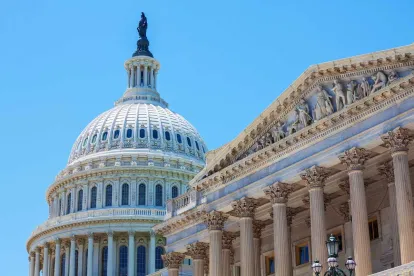DOL Proposes Changes to Overtime Regulations. On August 30, 2023, the U.S. Department of Labor (DOL) announced that it would issue a notice of proposed rulemaking to amend the regulations implementing the overtime provisions of the Fair Labor Standards Act. The effort represents another swing of the partisan pendulum, as this is the third administration in a row to propose changes to these regulations. In 2016, the Obama administration increased the salary basis threshold to $47,476 per year, but the regulation was enjoined and then struck down by a federal court as contrary to congressional intent. The Trump administration followed with its own overtime rule changes, which set the salary threshold at the current $35,568 per year. This week’s proposal:
- Sets the salary basis to the 35th percentile of weekly earnings of full-time salaried workers in the lowest-wage census region. This translates to a salary basis of $55,068 per year ($1,059 per week)—a 55 percent increase. However, because this is not a firm numerical figure but is instead based on evolving data, the proposal notes that this threshold level could change, and perhaps climb as high as $60,209 per year ($1,158 per week) in just the first quarter of 2024.
- Increases the total annual compensation requirement for highly compensated employees from $107,432 per year to $143,988 per year, based on annualized weekly earnings amount of the 85th percentile of full-time salaried workers nationally.
- Automatically updates the salary basis threshold every three years.
The DOL is not proposing to change the duties test.
Comments are due sixty days after the proposed rule is published in the Federal Register. Any final rule likely will not issue until 2024 and will undoubtedly be subject to multiple legal challenges. Keith E. Kopplin and Lee E. Tankle have the details.
OSHA Looks to Resuscitate Failed “Walkaround” Effort. On August 30, 2023, the Occupational Safety and Health Administration published a proposed rule, titled, “Worker Walkaround Representative Designation Process.” The proposal attempts to codify a controversial interpretation set forth in a 2013 letter that was subsequently withdrawn. Under this week’s proposal, outside third-party employee representatives may accompany OSHA compliance safety and health officers during workplace inspections if they have “relevant knowledge, skills, or experience with hazards or conditions in the workplace or similar workplaces.” According to the proposal, third parties may include a “representative from a worker advocacy group, community organization, or labor union.” Comments are due on October 30, 2023. John D. Surma and Savannah M. Selvaggio have the details.
NLRB Update. So much for a sleepy August at the National Labor Relations Board (NLRB), as decisions continue to pour out of the agency with the expiration of Member Gwynne Wilcox’s term. Here is the latest:
- Card check. Thomas M. Stanek and Zachary V. Zagger have the details on the Board decision last week that dramatically tilts the workplace representation process in favor of labor unions. The new test requires an employer to recognize a union when presented with authorization cards unless the employer affirmatively asks the Board to conduct a secret-ballot election. If the employer asks for an election and subsequently commits an unfair labor practice, the Board can order the employer to recognize the union. When combined with the return of both “ambush” elections and the “federal employee-handbook police” (as the dissent put it in a 2022 Board decision), it is clear that the new representation process is designed to boost unions’ sagging membership numbers in the wake of the Protecting the Right to Organize (PRO) Act’s failure in the U.S. Congress.
- Adverse employment actions and union animus. In a decision released on August 28, 2023, the Board clarified its Wright Line standard for determining whether an adverse employment action was motivated by an employee’s protected activity. In dissent, Member Marvin Kaplan argued that it was unnecessary for the majority to revisit Wright Line, and he noted that “general hostility toward a union is insufficient to demonstrate that employee protected activity was a ‘motivating factor’ in a specific adverse action taken by an employer.”
- Expanded protected concerted activity. In another case, the Board expanded the definition of “concerted,” indicating that actions by a single employee may be “concerted” when the “employee’s conduct sought to initiate, induce, or prepare for group action, or was related to group action.” Member Kaplan disagreed with the majority’s assertion that “concerted activity can be established by protected activity taken without the requisite intent toward group action.”
- Wilcox departs, but senator wants assurances. As the Buzz mentioned last week, Gwynne Wilcox ended her term as a member of the NLRB on August 27, 2023. The Board is now down to three members: Chair Lauren McFerran and David Prouty are the remaining Democrats, while Marvin Kaplan continues to serve as the sole Republican. But due to the fact that Wilcox’s renomination has been teed up for a post-Labor Day vote in the U.S. Senate, Senator Bill Cassidy, ranking member of the Senate Committee on Health, Education, Labor and Pensions (HELP), wants to ensure that Wilcox is no longer on the Board. In a letter dated August 28, 2023, Senator Cassidy wrote to Chair McFerran seeking “assurances the National Labor Relations Board (NLRB or Board) has terminated [Wilcox’s] employment appropriately and is following all separation protocols for a federal appointee whose term has expired.” The letter goes on to ask McFerran whether Wilcox has been inappropriately moved to an advisory position at the Board, and whether she still has access to Board facilities, computers, emails systems, and the like. The letter is indicative of the political importance of the Board.
The Onion Knights. This week in 1958, President Dwight D. Eisenhower signed into law the Onion Futures Act. The law was in response to the 1955 actions of two Chicago traders who cornered the onion market by amassing 30 million pounds of onions, as well as onion futures contracts. The traders made millions first by increasing the price of onions, and then by subsequently taking short positions while flooding the market with onions. While the onion speculators prospered, many merchants and farmers went bankrupt. In response to the resulting public outcry, then-congressman Gerald Ford (R-MI) sponsored the bill to ban futures trading in onions. The law, which is still in effect, was subsequently amended to include box office receipts. It reads:
No contract for the sale of motion picture box office receipts (or any index, measure, value, or data related to such receipts) or onions for future delivery shall be made on or subject to the rules of any board of trade in the United States. The terms used in this section shall have the same meaning as when used in the Commodity Exchange Act.




 />i
/>i

